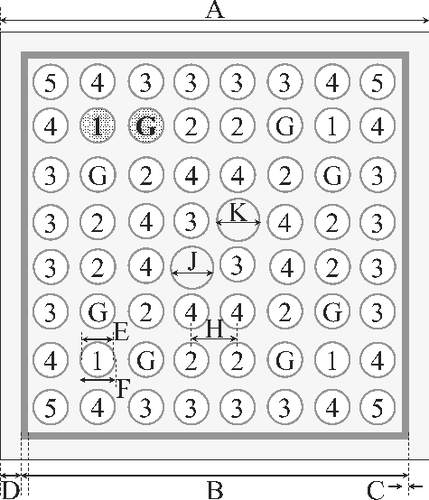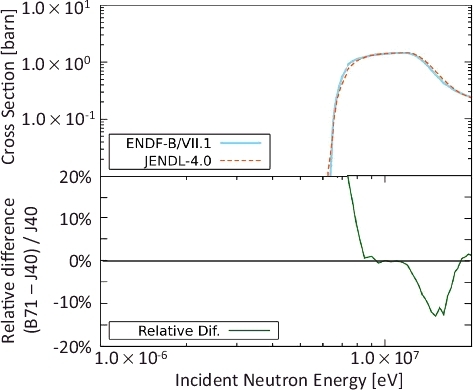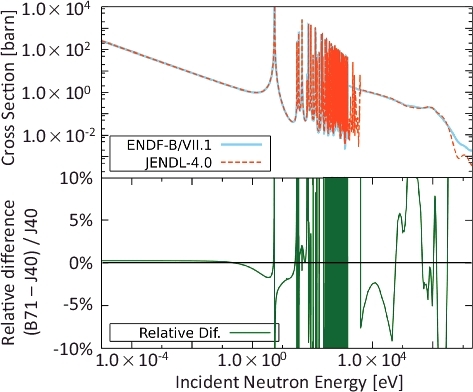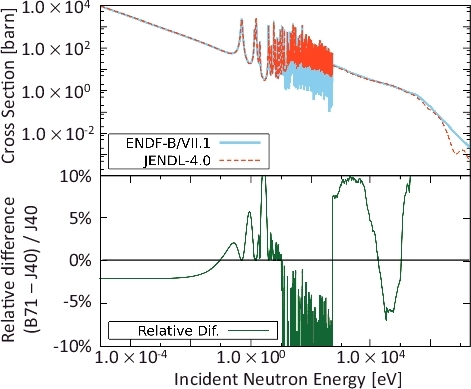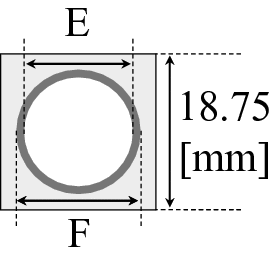 ?Mathematical formulae have been encoded as MathML and are displayed in this HTML version using MathJax in order to improve their display. Uncheck the box to turn MathJax off. This feature requires Javascript. Click on a formula to zoom.
?Mathematical formulae have been encoded as MathML and are displayed in this HTML version using MathJax in order to improve their display. Uncheck the box to turn MathJax off. This feature requires Javascript. Click on a formula to zoom.ABSTRACT
Criticality safety of the fuel debris from the Fukushima Daiichi Nuclear Power Plant is one of the most important issues, and the adoption of burnup credit is desired for criticality safety evaluation. To adopt the burnup credit, validation of the burnup calculation codes is required. Assay data of the used nuclear fuel irradiated by the Fukushima Daini Nuclear Power Plant Unit 2 are evaluated to validate the SWAT4.0 code for solving the BWR fuel burnup problem. The calculation results revealed that the number densities of many heavy nuclides and fission products show good agreement with the experimental data, except for those of 237Np, 238Pu, and samarium isotopes. These differences were considered to originate from inappropriate assumption of void fraction. Our results implied overestimation of the (n, γ) cross-section of 237Np in JENDL-4.0. The Calculation/Experiment – 1 (C/E–1) value did not depend on the type of fuel rod (UO2 or UO2–Gd2O3), which was similar to the case of PWR fuel. The differences in the number densities of 235U, 239Pu, 240Pu, 241Pu, 149Sm, and 151Sm have a large impact on keff. However, the reactivity uncertainty related to the burnup analysis was less than 3%. These results indicate that SWAT4.0 appropriately analyzes the isotopic composition of BWR fuel, and it has sufficient accuracy to be adopted in the burnup credit evaluation of fuel debris.
1. Introduction
Criticality safety of the fuel debris is one of the most important issues in the decommissioning of the Fukushima Daiichi Nuclear Power Plant. The fresh fuel assumption is used in conventional criticality safety evaluations. Because the spatial distribution, shape, and composition of fuel debris are not known, the optimum moderation assumption would be required for criticality safety evaluation of fuel debris. If optimum moderation and fresh fuel composition are assumed, keff of the fuel debris could exceed 1.0 in most of cases which the fuel debris contains water and does not contain neutron absorbers such as gadolinium. These assumptions increase the number of fuel debris retrieval attempts and the space required for storing it from the view point of criticality safety. The adoption of the burnup credit has been studied widely for the criticality safety control of the facility treating used fuel [Citation1] and it will be also effective for the treatment of the fuel debris. For this purpose, the prediction accuracy of the isotopic composition of used nuclear fuel must be investigated.
Japan Atomic Energy Agency (JAEA) developed a burnup calculation code SWAT4.0 [Citation2,Citation3] to obtain reference calculation results of the isotopic composition of the used nuclear fuel. SWAT4.0 integrates the neutronics calculation codes MVP [Citation4], SRAC2006 [Citation5], or MCNP [Citation6] with the burnup calculation code ORIGEN2 [Citation7]. SWAT4.0 is suitable for calculating the isotopic composition of used nuclear fuel because it treats about 1400 nuclides [Citation8] and can be used for calculating the amount of actinides and fission products, decay heat, radiation dose, and gamma ray spectrum analysis.
The SWAT4.0 code has been validated by analyzing the used nuclear fuel assay data acquired by post-irradiation examinations (PIE) of pressurized water reactor (PWR) fuel [Citation9], and it showed the high prediction accuracy for PWR fuel. However, the prediction accuracy of SWAT4.0 for boiling water reactor (BWR) fuel has not been investigated sufficiently. The evaluation of BWR fuel requires more complicated treatment than that of PWR fuel. The neutronics heterogeneity of BWR fuel is stronger than that of PWR fuel because it must consider the effect of Gd fuel rods, water rods, axial void distribution, and 235U enrichment distribution of the fuel rods. Therefore, it is difficult to estimate the applicability of the code for BWR fuel based on the analysis results for PWR fuel.
We investigate the applicability of SWAT4.0 to BWR fuel by analyzing the PIE data obtained from 2F2DN23 [Citation10–12], which is an 8 × 8 STEP-I BWR fuel assembly loaded in the Fukushima Daini Nuclear Power Plant Unit 2 (2F2). Japan Atomic Energy Research Institute (JAERI), the predecessor of the JAEA, measured the assay data, namely, the isotope composition of heavy nuclides and fission products, in the 1990s.
To investigate the applicability of SWAT4.0 to the criticality safety evaluation of fuel debris, we also evaluated the effect of isotopic composition difference on keff. Generally speaking, when the nuclide density is given correctly, the estimated lower limit criticality multiplication factor of the current state-of-the-art calculation code system is 0.98 for many fissile material systems [Citation13]. However, in order to take the change of the fuel composition during the burnup into account, it is indispensable to evaluate the uncertainty of keff related to the nuclide density obtained by the burnup calculation. If the uncertainty of the burnup calculation is less than 0.03, i.e. 3%, we could adopt the maximum permissible multiplication factor, i.e. upper safety limit of keff of 0.95, which is the conventional criterion of the subcriticality assessment. To estimate this uncertainty, we compared keff obtained by the pin-cell calculations adopting the number densities by the burnup calculation and the experiment.
This paper is organized as follows. Section 2 presents an overview of the specifications of 2F2DN23. The calculation conditions and results are described in Section 3. Finally, the conclusions are summarized in Section 4.
2. Overview of 2F2DN23
The geometric configuration of the fuel assembly and the axial average enrichment of each fuel pin are shown in and summarized in and , respectively [Citation10–12, Citation14–15]. The assembly consists of five types of UO2 fuel pins, one type of Gd fuel pin, and two water rods. The operating history of 2F2DN23 is shown in , and the average exposure of the fuel assembly is 33.4 GWd/t [Citation10]. The shaded pins in are the objective fuel pins of the PIE, i.e. the most highly enriched UO2 fuel pin (SF98) and Gd fuel pin (SF99). From SF98 and SF99, 8 and 10 samples, respectively, were taken, and their isotopic composition data were measured using mass, α, and γ spectrometry [Citation10]. The sampling positions in the fuel pin, temperature, in-channel void fraction of the moderator and radial average enrichment of the fuel are given in [Citation10]. Note that the out-channel void fraction of the moderator is 0% for all samples.
Table 1. Size of 8 × 8 STEP-I BWR fuel assembly [Citation13–15]
Table 2. The axial average enrichment for fuel pins [Citation10]
Table 3. Operating history of 2F2DN23 [Citation10]
Table 4. The sampling position, temperature, in-channel void fraction, and radial average enrichment in each sample [Citation10]
3. Calculation conditions and results
3.1. Calculation conditions
The calculation conditions of SWAT4.0 are listed in . As described in Section 1, SWAT4.0 integrates the neutronics calculation code MVP, SRAC2006, or MCNP with the burnup calculation code ORIGEN2. In this calculation, MVP is used as the neutron transport solver. Numbers of neutron history per cycle, cycle number, and skip cycle number of the MVP calculation are 10,000, 1100, and 100, respectively. Cross-section data and fission yield data are taken from JENDL-4.0 [Citation17]. Because the (n, γ) cross-sections of 156Eu from JENDL-4.0 is extremely large and this (n, γ) cross-sections has significant impact on the number density of 157Gd and 158Gd, we used the revised 156Eu cross-section data from JENDL-4.0u1 to appropriately calculate the number density of them. Nuclide generation chain data such as decay modes, branching ratios, and half-life are taken from ENSDF [Citation18] and JENDL/FPD-2000 [Citation19].
Table 5. Calculation conditions of SWAT4.0
Since the actual temperature and void history data were not provided, the typical and constant temperature and void fraction data [Citation10] given in are used. The 235U enrichment distribution at each sample position used in this study is shown in . The two-dimensional single-fuel assembly model is adopted as the calculation geometry. Although precise 235U enrichment distribution data are not given, the initial 235U enrichment data of the measured samples and the average 235U enrichment values of whole assembly and axial and radial direction are provided as the initial fuel composition data in the reference [Citation10]. In this analysis, the 235U enrichment distribution at each sample position is calculated to preserve the average 235U enrichment.
Table 6. The 235U enrichment for fuel pins at each sample estimated in this calculation
To appropriately evaluate the depletion of gadolinium isotopes, we used the predictor-corrector method [Citation20], and each Gd fuel rod is divided into 12 regions with equal-sized surfaces along the radial direction. Note that a few samples, namely, SF98-1, SF98-2, SF99-1, and SF99-10, are omitted from this comparison. As summarized in , these samples are located at the top/bottom of the active fuel region. Because the natural uranium is loaded in these regions and their axial flux distribution is not flat, these samples are not suitable for benchmarking the usual burnup calculation under the typical irradiation condition.
3.2. Calculation results
The experimental results and the Calculation/Experiment – 1 (C/E–1) values of the heavy nuclides and the fission products of the SF98 and SF99 samples are given in to . The average absolute C/E–1 values of the major heavy nuclides, namely, 235U, 238U, 239Pu, 240Pu, and 241Pu, in the SF98 samples (UO2 fuel) are 2.2%, 0.1%, 3.9%, 2.9%, and 5.1%, respectively. The average absolute C/E–1 values of the major fission products, namely, 148Nd, 134Cs, 137Cs, in the SF98 samples are 0.2%, 3.3%, and 7.1%, respectively. The Nd-148 method, which estimates the numbers of fissions occurred in the fuel sample based on the measured numbers of 148Nd isotope, was used to evaluate the burnup values of the PIE data [Citation21]. Because the C/E–1 value of 148Nd is almost 0%, the calculated exposure values well agree with the measured ones. As given in and , the general tendency of the C/E–1 values does not depend on the fuel type.
Table 7. Experimental results of SF98 samples in 2F2DN23 (as of after irradiation) [Citation10]
Table 8. C/E–1 values of SF98 samples in 2F2DN23 with SWAT4.0
Irrespective of the types of fuel rods (UO2 or UO2–Gd2O3), the C/E–1 values of almost all nuclides, except 237Np, 238Pu, 241Am, and samarium isotopes, are within ± 5%. Though the measurement uncertainty of 241Am is less than 2% [Citation10], the other calculation results also indicate that the absolute C/E–1 value of 241Am is larger than that of the other isotopes [Citation22]. The measurement uncertainty of 241Am might be larger than 2%.
The prediction accuracy of the residual gadolinium isotopic ratio is investigated for SF99 samples because evaluation of the residual gadolinium amount in Gd fuel pins is interested from the view point of the criticality safety of the fuel debris from the Fukushima Daiichi Nuclear Plant accident [Citation23].
shows the C/E–1 values of the isotopic ratio of Gd in the SF99 samples. Although the C/E–1 values of 156Gd, 158Gd, and 160Gd are within 1%, those of 154Gd, 155Gd, and 157Gd are higher. Since the capture cross-sections of 154Gd, 155Gd and 157Gd are tremendously large, these nuclides are almost transmuted during the irradiation. The number density of gadolinium is measured by the mass spectrometry measurement [Citation10] and the error in this measurement technique is small. However, the error in the chemical separation could have impact on the isotopic ratio of 154Gd and 155Gd [Citation24]. This is because gadolinium and europium are difficult to separate chemically and 154Gd and 155Gd could be contaminated by their parent nuclides, 154Eu and 155Eu which have the half-lives of 8.60 and 4.75 yr, respectively. The error in the chemical separation must be considered for extremely small isotopic ratios. However, the reference 10 does not provide us with such detailed data.
Since the capture cross-sections of 156Gd and 158Gd are very small, the isotopic ratio of them contains the initial composition of these nuclides and the total number of reactions involving 155Gd and 157Gd. This result indicates that SWAT4.0 appropriately analyzes the depletion of 155Gd, and 157Gd.
The reason for the larger difference in 237Np, 238Pu, and samarium isotopes is investigated. As described in Section 3.1, temperature and void history data are not given in the 2F2DN23 datasets. The impact of void history data is considered because the temperature does not change considerably with operating conditions and the temperature history data does not have a major effect on the isotopic compositions of used nuclear fuel.
The effects of variations in the void fractions of the SF98-4 and 6 samples are given in . The C/E–1 values of 237Np, 238Pu, and samarium isotopes vary by ± 3%, ± 7%, and ± 0%–5%, respectively. Although the actual void fraction varies with the operating condition, the typical and the constant void fractions are used in this calculation. The results indicate that the actual and the precise void history data are required to improve the prediction accuracy of number densities of 237Np, 238Pu, and samarium isotopes.
Although the C/E–1 values of 237Np and 238Pu improved upon considering the void history data, the differences remain. To investigate the cause of the differences in 237Np and 238Pu, we focus on the generation processes of 237Np and 238Pu. The main generation processes of 237Np and 238Pu are as follows [Citation25]:
To investigate the cause of the differences in 237Np and 238Pu, we evaluated the impact of the differences in the cross-sections of these nuclides between JENDL-4.0 and ENDF/B-VII.1 data [Citation26].
The number density of 242Cm is small even though the experimental data are provided as of just after the irradiation. In the calculation results, the number density of 238Pu is 10 times higher than that of 242Cm. Therefore, the first-generation process does not have any significant impact on the number density of 238Pu.
shows the (n, 2n) cross-section of 238U in JENDL-4.0 and ENDF/B-VII.1. Although the threshold of the (n, 2n) reaction is 6.2 MeV and only a small part of the neutron flux has a magnitude higher than 6.2 MeV, the amount of 238U is considerably higher than that of the other nuclides. Therefore, the difference in the (n, 2n) cross-section will affect the number densities of 237Np and 238Pu. To estimate the effect of the difference in the (n, 2n) cross-section of 238U, we performed the calculation by using the nuclear data of 238U of ENDF/B-VII.1 instead of JENDL-4.0. shows the results of SF99-4 and 6 samples. The differences in the C/E–1 values of 237Np and 238Pu in SF99-4 and 6 samples are about 2%. This result indicates that an accurate (n, 2n) cross-section of 238U is required to predict the number densities of 237Np and 238Pu more accurately.
shows the (n, γ) cross-section of 236U in JENDL-4.0 and ENDF/B-VII.1. The boundary energy between the resolved and the unresolved resonance regions of JENDL-4.0 (4.0 keV) is higher than that of ENDF/B-VII.1 (1.5 keV). To estimate the impact of the difference in the resonance boundary, we performed the calculation by using nuclear data of 236U of ENDF/B-VII.1 instead of JENDL-4.0. lists the obtained C/E–1 values of the SF99-4 and 6 samples. The differences in the C/E–1 values of 237Np and 238Pu are about −2%. This result indicates that an accurate (n, γ) cross-section of 236U is also required to predict the number densities of 237Np and 238Pu more accurately.
shows the (n, γ) cross-section of 237Np in JENDL-4.0 and ENDF/B-VII.1. The (n, γ) cross-section of 237Np in JENDL-4.0 is larger than that in ENDF/B-VII.1 where the incident neutron energy is less than 0.1 eV. To estimate the effect of the difference in the (n, γ) cross-section of 237Np, burnup calculations are performed using 237Np nuclear data of ENDF/B-VII.1 instead of JENDL-4.0. lists the obtained C/E–1 values of the SF99-4 and 6 samples. The differences in the C/E–1 values of 237Np and 238Pu in SF99-4 and 6 samples are about 1% and −2%, respectively. When 237Np nuclear data of ENDF/B-VII.1 are used instead of JENDL-4.0, the C/E values of 237Np and 238Pu improve simultaneously. This result indicates that the (n, γ) cross-section of 237Np in JENDL-4.0 might be overestimated.
In comparison with the previous calculation for PWR fuel [Citation9], by using the assumed 235U enrichment and typical and constant void fraction, the resulting trend in C/E–1 values is similar, and the number densities of almost all nuclides could be evaluated to within ± 10%, irrespective of the presence of Gd in the initial pellet composition. These results indicate that SWAT4.0 could estimates the isotopic composition of the used PWR and BWR fuels with sufficient accuracy.
3.3. Estimation of effect of isotopic composition difference on k eff
As described in Section 1, the criticality safety of the fuel debris from the Fukushima Daiichi Nuclear Power Plant is one of the most important research issues in Japan, and we intend to adopt the burnup credit by using the calculation results of SWAT4.0. To investigate the applicability of SWAT4.0, the effects of differences in isotopic composition on keff are evaluated.
Pin-cell calculations were carried out by changing the isotopic composition on the basis of the results of PIE data analysis. shows the adopted pin-cell geometry. The pellet diameter and cladding outer diameter are identical to those of the 2F2DN23 fuel assembly, as given in . The fuel rod pitch is modified from 16.30 mm to 18.75 mm to use the identical H/U ratio of the fuel assembly geometry.
Numbers of neutron history per cycle, cycle number, and skip cycle number in the MVP calculation are 30,000, 1100, and 100, respectively. JENDL-4.0 [Citation17] was used for the neutronics calculation. The number density of each nuclide was changed from the experimental value to the calculated value one by one. All nuclides present in the fuel pin are listed in and . Other heavy nuclides and fission products were not considered.
Table 9. Experimental results of SF99 samples in 2F2DN23 (as of after irradiation) [Citation10]
Table 10. C/E–1 values of SF99 samples in 2F2DN23 with SWAT4.0
Table 11. The comparison of isotopic ratio of Gd in SF99 samples [Citation10]
Table 12. Variation of C/E–1 values with void fraction in SF98-4 and 6 samples
Table 13. Variation of C/E–1 values with changing 238U cross-section from JENDL-4.0 to ENDF/B-VII.1 in SF98-4 and 6 samples
Table 14. Variation of C/E–1 values with changing 236U cross-section from JENDL-4.0 to ENDF/B-VII.1 in SF98-4 and 6 samples
Table 15. Variation of C/E–1 values with changing 237Np cross-section from JENDL-4.0 to ENDF/B-VII.1 in SF98-4 and 6 samples
and list the calculation results. The first and the second rows of and present keff obtained from the pin-cell calculations performed using the experimental number density and its standard deviation, respectively. The other rows with isotopic symbols present the relative differences of keff when the number density of each nuclide is changed to the corresponding calculated value. Large differences which are greater than 0.1%Δk/k are underlined.
Table 16. The effects of the isotopic composition difference on keff in SF98 samples
Table 17. The effects of the isotopic composition difference on keff in SF99 samples
The impact of the difference in isotopic composition on keff is 0.2%–2.1%Δk/k. From the viewpoint of the criticality safety of fuel debris, the prediction accuracy of the fissile nuclides is important. Namely, the differences in fissile nuclides, 235U, 239Pu, and 241Pu, have large impact on keff. Generally, the differences in the number densities of the other heavy nuclides and fission products have small impacts on keff. Although the differences in the number densities of 237Np, 238Pu are large, their impacts on keff are negligible. The differences in the number densities of 240Pu, 149Sm and 151Sm also have large impact on keff. Concerning the 240Pu, since the number density is larger than those of other heavy nuclides and it has large resonance in the thermal energy region, its number density has strong impact on keff. Since the capture cross-sections of 149Sm and 151Sm are significantly large and the C/E–1 values of these nuclides are larger than those of other nuclides, these nuclides strongly affect keff.
On the basis of the above analyses, the reactivity uncertainty caused by the burnup analysis, i.e. the isotopic composition evaluation, by SWAT4.0 is less than 3%. Since we adopt the upper subcriticality limit of 0.95 in usual criticality safety evaluation, these results indicate that SWAT4.0 has adequate prediction accuracy of the isotopic composition to be adopted in the burnup credit analysis of the fuel debris from the Fukushima Daiichi Nuclear Power Plant.
4. Conclusions
It is desired to adopt the burnup credit in the treatment of the fuel debris from the Fukushima Daiichi Nuclear Power Plant, while balancing between the careful consideration of criticality safety and the feasibility of practical treatment. For this purpose, the prediction accuracy of the isotopic composition of the used nuclear fuel needs to be investigated.
To validate the prediction accuracy of SWAT4.0 for used BWR fuel, we evaluated the PIE data taken from 2F2DN23, an 8 × 8 STEP-I BWR fuel assembly loaded in the Fukushima Daini Nuclear Power Plant Unit 2. SWAT4.0 is an integrated burnup analysis code system that combines the neutronics calculation solvers MVP, SRAC2006, or MCNP with the burnup calculation solver ORIGEN2. In this study, we used the MVP code as the neutronics calculation solver and a two-dimensional single-fuel assembly model as the calculation geometry.
The calculation results showed good agreement with the experimental results, except for 237Np, 238Pu, and samarium isotopes. To improve the prediction accuracy of these isotopes, we required actual void fractions. Accurate (n, 2n) cross-section of 238U and (n, γ) cross-sections of 236U and 237Np can be used to improve the prediction accuracy of the number densities of 237Np and 238Pu. Our results implied overestimation of the (n, γ) cross-section of 237Np in JENDL-4.0. The C/E–1 value of the isotopic ratio of gadolinium in Gd fuel pins also showed good agreement and SWAT4.0 appropriately analyzes the depletion of Gd. The obtained C/E–1 value of used BWR fuel was similar to that of PWR fuel which had been obtained in the previous analyses. Namely, the general tendency of the C/E–1 values does not change depending on the fuel type. These results indicate that the prediction accuracy of SWAT4.0 is adequate not only for PWR fuel but also for BWR fuel.
To investigate the applicability of SWAT4.0 to criticality safety analysis, we performed the pin-cell calculations and evaluated the effect of isotopic composition differences on keff. The calculation results indicate that the impact of the difference in isotopic composition on keff is 0.2%–2.1%Δk/k. As expected, the differences of the fissile nuclides, namely, 235U, 239Pu, and 241Pu, and 240Pu, 149Sm, and 151Sm have large impacts on keff, whereas the other heavy nuclides and fission products have negligible impacts on keff. The reactivity uncertainty of the burnup analysis by SWAT4.0 was less than 3%. Since the estimated lower limit criticality multiplication factor of the current state-of-the-art calculation code system is 0.98 for many fissile material systems when the nuclide density is given correctly, less than 3% uncertainty of keff related to the burnup calculation is suitable to adopt the maximum permissible multiplication factor of 0.95.
These results indicate that SWAT4.0 has adequate prediction accuracy and can be adopted in the burnup credit analysis of the fuel debris from the Fukushima Daiichi Nuclear Power Plant.
Disclosure statement
No potential conflict of interest was reported by the authors.
References
- Nuclear Fuel Cycle Facility Safety Research Committee. A guide introducing burnup credit, preliminary version. Tokai-mura, Jap an: Japan Atomic Energy Research Institute; 2001. JAERI-Tech 2001-055 [in Japanese].
- Kashima T, Suyama K, Takada T. SWAT-4.0 – The integrated burnup code system driving continuous energy monte carlo codes MVP, MCNP and deterministic calculation code SRAC. Tokai-mura, Japan: Japan Atomic Energy Agency; 2015. JAEA-Data/Code 2014-028 [in Japanese].
- Suyama K, Mochizuki H. revised burnup code system SWAT: description and validation using post irradiation examination data. Nucl. Technol. 2002;138:97–110.
- Nagaya Y, Okumura K, Mori T, et al. MVP/GMVP II: general purpose Monte Carlo codes for neutron and photon transport calculations based on continuous energy and multigroup methods. Tokai-mura, Ja pan: Japan Atomic Energy Research Institute; 2004. JAERI-1348.
- Okumura K, Kugo T, Kaneko K, et al. SRAC2006: a comprehensive neutronics calculation code system. Tokai-mura, Ja pan: Japan Atomic Energy Agency; 2007. JAEA-Data/Code 2007-004.
- X-5 Monte Carlo Team. MCNP – a general Monte Carlo N-Particle transport code, version 5. Los Alamos, USA: Los Alamos National Laboratory; 2003. LA-UR-03-1987.
- Croff GA. ORIGEN2 – A Revised and Updated Version of the Oak Ridge Isotope Generation and Depletion Code. Los Alamos, US A: Oak Ridge National Laboratory; 1980. ORNL-5621.
- Okumura K, Sugino K, Kojima K, et al. A set of ORIGEN2 cross section libraries base on JENDL-4.0: ORLIBJ40. Toka-mura, Jap an: Japan Atomic Energy Agency; 2012. JAEA-Data/Code 2012-032 [in Japanese].
- Yamamoto K, Akie H, Suyama K, et al. Criticality safety evaluation for the direct disposal of used nuclear fuel - preparation of data for burnup credit evaluation. Tokai-mura, Japa n: Japan Atomic Energy Agency; 2015. JAEA-Technology 2015-019 [in Japanese].
- Nakahara Y, Suyama K, Suzuki T. Technical development on burn-up credit for spent LWR fuels. Tokai-mura, Japan: Japan Atomic Energy Research Institute; 2000. JAERI-Tech 2000-071 [in Japanese].
- Nakahara Y, Suyama K, Inagawa J, et al. Nuclide composition benchmark data set for verifying burnup codes on spent light water reactor fuels. Nucl Technol. 2002;137:111–126.
- Mochizuki H, Suyama K, Nomura Y, et al. Spent fuel composition database system on WWW –SFCOMPO on WWW Ver.2-. Tokai-mura, Jap an: Japan Atomic Energy Research Institute; 2001. JAERI-Data/Code 2001-020 [in Japanese].
- Working group on nuclear criticality safety data nuclear criticality safety handbook version 2. Tokai-mura, Jap an: Japan Atomic Energy Research Institute; 1999. JAERI-1340.
- Okuno H, Naito Y, Ando Y. OECD/NEA burnup credit criticality benchmarks phase IIIA: criticality calculations of BWR spent fuel assemblies in storage and transport. Tokai-mura, Japa n: Japan Atomic Energy Research Institute; 2000. JAERI-Research-2000-041.
- Yamamoto T. Compilation of measurement and analysis results of isotopic inventories of spent BWR fuels. Tokai-mura, Jap an: Japan Nuclear Energy Safety Organization; 2009.
- Aziz M., Hassan MI. Analysis of a neutronic computational model for boiling water reactor assembly using MCNP code. J Nucl Radiat Phys. 2009;4:43–53.
- Shibata K, Iwamoto O, Nakagawa T, et al. JENDL-4.0: a new library for nuclear science and technology. J Nucl Sci Technol. 2011 Jan;48:1–30.
- Tepel WJ. ENSDF – the evaluated nuclear structure data file. Comput Phys Commun. 1984;33:129–146.
- Katakura J, Yoshida T, Oyamatsu K, et al. JENDL FP decay data file 2000. Tokai-mura, Jap an: Japan Atomic Energy Research Institute; 2001. JAERI-1343.
- Stamm'ler RJJ., Abbate MJ. Methods of steady-state reactor physics in nuclear design. London: Academic Press; 1983.
- Suyama K, Mochizuki H. Effect on neutron induced reactions of neodymium-147 and 148 on burnup evaluation. J Nucl Sci Technol. 2005;42:661–669.
- Yamamoto T, Yamamoto M. Nuclear analysis of PIE data of irradiated BWR 8×8-2 and 8×8-4 UO2 fuel assemblies. J Nucl Sci Technol. 2012;45:1193–1214.
- OECD/NEA. Working party on nuclear criticality safety nineteenth of the working party on nuclear criticality safety summary record. Paris, Fra nce: OECD/NEA; 2015. NEA/NSC/WPNCS/DOC(2015)13.
- OECD/NEA. Spent nuclear fuel assay data for isotopic validation. Paris, Fran ce: OECD/NEA; 2015. NEA/NSC/WPNCS/DOC(2011)5.
- Oizumi A, Jin T, Yokoyama K, et al. Database for nuclear data sensitivity of burnup composition in light water reactors. Tokai-mura, Jap an: Japan Atomic Energy Agency; 2013. JAEA-Data/Code 2013-019 [in Japanese].
- Chadwick BM, Herman M, Oblozinsky P, et al. ENDF/B-VII.1 nuclear data for science and technology: cross sections, covariances, fission product yields and decay data. Nuclear Data Sheets. 2011 Dec;112:2887–2996.

